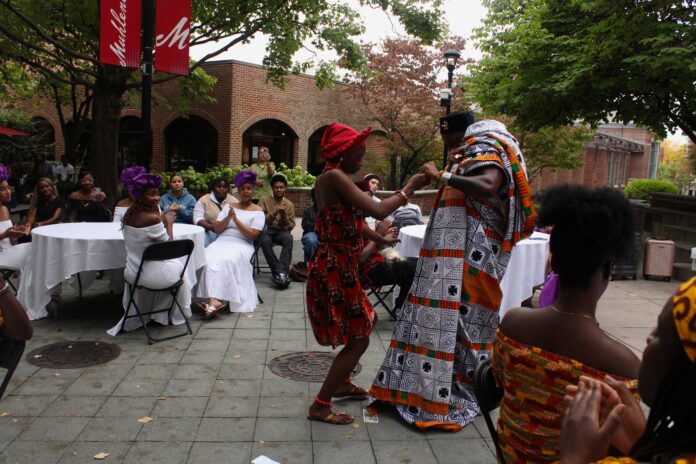
On Oct. 4, students and faculty alike gathered in Parent’s Plaza to support the African Students Organization (ASO). The group was hosting a faux wedding ceremony rooted in Ghanaian and Nigerian culture. The Plaza was elaborately decorated; on the platform were what looked like two white thrones adorned with purple flowers on vines. In front of these were four circular tables with reserved seats, surrounded on three sides by chairs for the attendees. Music of different African countries played.
As the participants of the wedding ceremony got ready, the attendees mingled with each other. Assistant Professor of History and Faculty Advisor of ASO Sarah Runcie, Ph.D., expressed her enthusiasm to be attending, “I’m here to support… and I’m really excited to be here at this event and to see this display of African culture!”
President Kathleen Harring, Ph.D. also attended, adding, “I am here because one of the best parts of my job is getting to attend student events. It’s a joy to learn about new cultures and enjoy good food and company.”
The ceremony began with a poem reading by Bernice Owusu ‘25, ASO’s president. “Bibini Baa [the title of the poem] is an original piece I wrote,” she said. “It expresses my journey as a Ghanaian American who is also navigating being Black in America and learning how to appreciate my African Roots.”
“We chose an African wedding because it’s more engaging, informative and fun,” said Owusu. She was right about all that, but especially about the fun—everyone very much enjoyed themselves. She continued: “Also, it is very different from a white wedding. We wanted to portray two different wedding traditions specifically from the Igbo people of Nigeria (Bride’s side) and the Akan people of Ghana (Groom’s side).” She went on to describe how African weddings differ from what many people in the West think of as a wedding. “With most African traditional weddings, marriage is the union between two families. In most cultures, a bride price is given to ask for the bride’s hand in marriage and the bride has a say on whether to accept it or not. If [the families are] Christian, a white wedding is followed a day after the traditional wedding. This pattern of marriage ceremony is still practiced today, with extravagant fashion, lots of food, music and dancing.”
All of those elements were present at the ceremony. The groom’s family and the bride’s family processed in to their own theme music, followed by the groom and his groomsmen and then the bride and her bridesmaids. Everyone wore exquisite traditional clothing, including sandals, headwraps or head coverings and flowing dresses. Owusu said “We worked with an African Designer for this event.”
A “money dance” performed by the groom’s family was followed by the presentation of gifts for the bride’s hand. She accepted, and the families were united. “You should always expect the ‘money dance’ at a West African wedding, because it shows wealth and an indication of praise and well-wishing,” Owusu said. The couple had their first dance, and then they left to get changed for the second, more celebratory half of the event.
“It’s a joy to learn about new cultures and enjoy good food and company.” -Kathleen Harring, Ph.D
During the break, the MINT dance team and the Perkulators performed and people were able to taste a sampling of the food offered at the event, which was a mix of various dishes from across Africa.
When the bride and groom returned, there was a series of dances between the couple and the families. Finally, everyone began to get their dinner from the buffet and to socialize. A lot of the food featured flavorful spices, one of the highlights being the Kenyan-style rice.
Harriet Komlatse ‘25, ASO’s treasurer said, “I am glad that it went well… I really appreciate the opportunity to show off our cultures. It was beautiful and I’m so glad that it was well received—a lot of people showed up,” she continued.
Owusu was very happy with how things went. “The planning process was a lot of work but luckily we had a good executive board team who were very committed to their roles and put their best foot forward. We also got a lot of help from the [Office of Multicultural Life] with counseling and budgeting. My favorite part was seeing how engaged the audience was and the smiles on everybody’s faces, which was the whole point of the event. I hope the people were able to see how beautiful, diverse and communal African culture is.”
If you missed this event, Owusu assures the campus community that “Muhlenberg should look forward to more exciting events from the African Student Organization!”




















